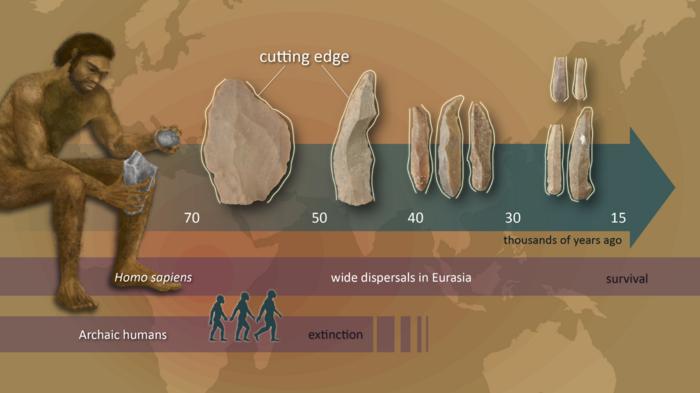Published in Nature Communications, the researchers’ insights into stone tool technology suggest that the commonly held view of a ‘revolution’ in culture and technology that allowed anatomically modern humans to outcompete Neanderthals and other archaic humans was a more nuanced and complicated process of cultural evolution.
The team of researchers focused on the Middle-Upper Paleolithic (MP-UP) cultural transition, an important boundary between two key phases in our evolution:
-
The Middle Paleolithic period (250,000 to 40,000 years ago) witnessed anatomically modern humans coexisting with Neanderthals and archaic humans existing at the same time. Culturally, anatomically modern humans and Neanderthals had similar stone tool technology, such as making tools using ‘Levallois methods’, which involved striking stones with a hammer-like tool.
-
The Upper Paleolithic period (50,000 and 12,000 years ago) is the period in which anatomically modern humans made wide geographic expansions, and archaic humans went extinct. During this period, new cultural elements emerged in various realms, including tool technology, food acquisition, seafaring, and artistic expression in ornaments and cave art.
Traditionally, scholars viewed the MP-UP transition as an abrupt change marked by the revolutionary emergence of new cultural elements. An example is the hypothesized sudden neural mutation in Homo sapiens, which resulted in their superior cognitive abilities. This change allowed them to ultimately outcompete other archaic humans and drive the Neanderthals to extinction. However, this study challenges this paradigm.
The researchers examined the productivity of stone-tools with a cutting-edge over a 50,000-year span that encompassed six cultural phases from the Late Middle Paleolithic, through the Upper Paleolithic, to the Epipaleolithic period. They discovered that the major increase in innovative productivity did not occur before or at the beginning of the widespread dispersal of Homo sapiens in Eurasia. Rather, it subsequently occurred after their initial dispersals, coinciding with the development of bladelet technology in the Early Upper Paleolithic.
This result shows a complicated process of cultural change involving multiple stages rather than a single ‘revolution.’
According to the lead researcher Professor Seiji Kadowaki, the cultural transition from the Middle to the Upper Paleolithic was a complex, evolutionary process involving multiple aspects and changes occurring over an extended period. He said, “In terms of cutting-edge productivity, Homo sapiens did not start to spread to Eurasia after a quick revolution in stone tool technology, but rather the innovation in the ‘cutting-edge’ productivity occurred later, in tandem with the miniaturization of stone tools like bladelets.”


